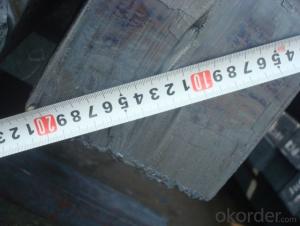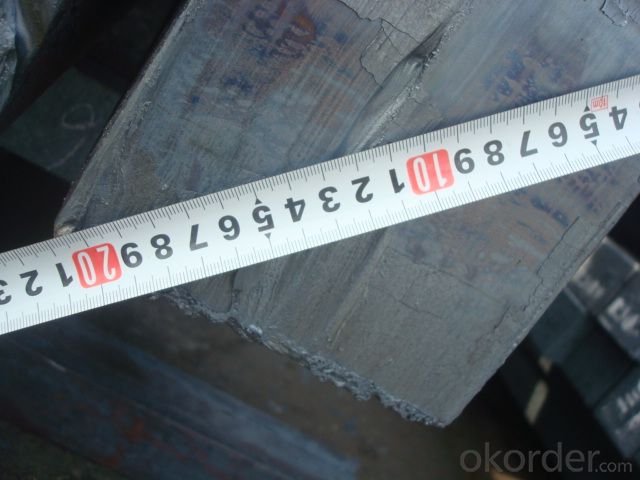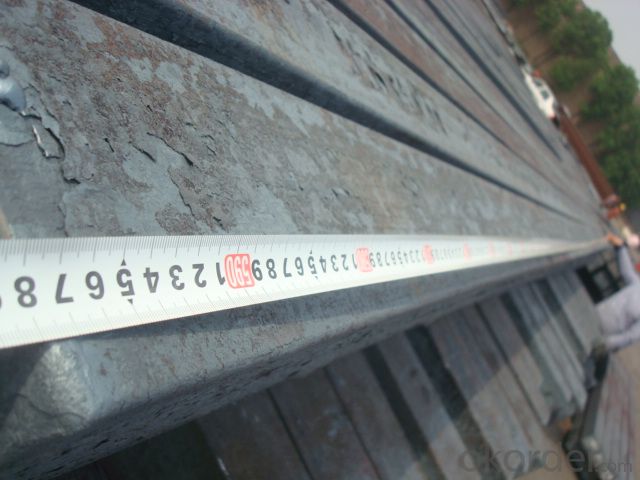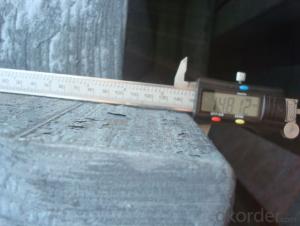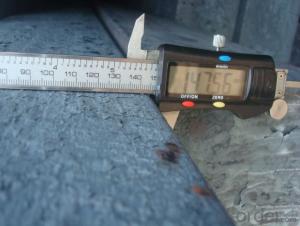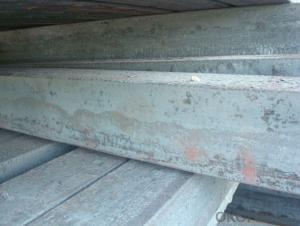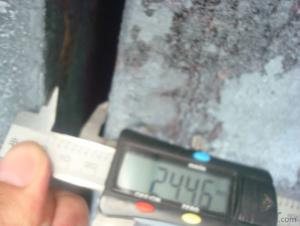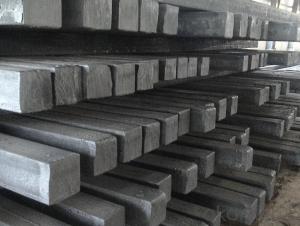Steel Bloom Manufactured by Big Blast Furnace
- Loading Port:
- Tianjin
- Payment Terms:
- TT OR LC
- Min Order Qty:
- 1000 m.t.
- Supply Capability:
- 100000 m.t./month
OKorder Service Pledge
OKorder Financial Service
You Might Also Like
Steel Bloom Manufactured by Big Blast Furnace
1.Structure of Steel Bloom Manufactured by Big Blast Furnace
Steel Bloom Manufactured by Big Blast Furnace is the raw material of all kinds of steel mill. Billet section of square, round, flat, rectangular and abnormity, etc Several, mainly related to shape of rolled products. Simple rolled section steel, choose cross section of square billet or rectangular billet. rolling The sector products such as flat steel, Angle steel, select the rectangular billet or slab. Had better profiled billet when production beams, channels, and in rolling process Lines and improve the yield. The raw material of round billet is the production of seamless tube.
2.Main Features of Steel Bloom Manufactured by Big Blast Furnace
Steel Bloom Manufactured by Big Blast Furnace section size should meet the requirements of rolling deformation and finished product quality, but also roll strength and biting condition of restrictions. General steel Billet section height H. And the roll diameter D The ratio of the ( namely H/D) Should be less than or equal to zero 0.5 . Length of steel billet by finishing temperature, Rolling time and the length of the product Or times ruler. When heated too long accident prone to bump the furnace wall of steel, too short, furnace bottom utilization rate is not high, influence the heating furnace production. For the production Choose a variety of steel and steel billet, should consider the affinities of billet, as far as possible in order to improve the productivity of the roughing mill, simplify the stock management of workshop.
3. Steel Bloom Manufactured by Big Blast Furnace Images
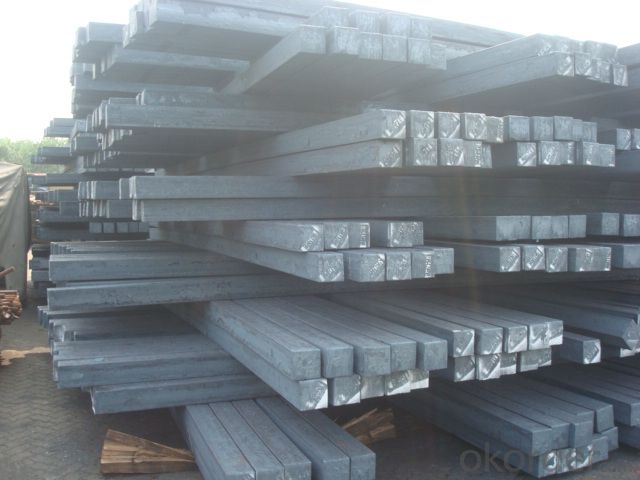
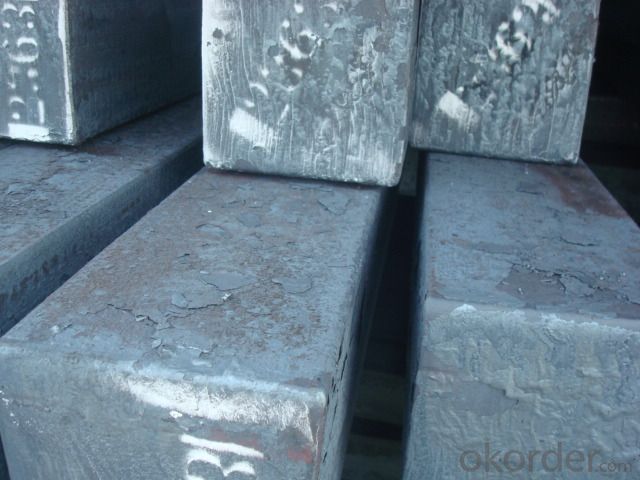
4. Steel Bloom Manufactured by Big Blast FurnaceSpecification
Steel Billet Manufactured by Blast Furnace rolled steel, after processing can be used for mechanical parts, forging parts, processing all kinds of steel, steel Q345B channel steel, wire rod is the role of the billet. Steel billet is used in the production of semi-finished products, generally cannot be used directly for the society. Steel billets and steel are strictly divided into standard, cannot decide to whether the business enterprise of the final product, and according to unified standards to perform the whole society. Typically, billet and the steel is relatively easy to distinguish, but for some steel billet, and have the same specification and same steel purposes (such as rolling tube billet), whether can be used for other industries, whether through steel processing process, whether through a finished product rolling mill processing to distinguish
Material standard The editor Range of thickness: 150-240 - mm + / - 5 mm width range: 880-1530 - mm + / - 20 mm Length: 3700-10000 - mm + / - 500 - mm Cross-sectional size: 64 * 64; 82 * 82; 98 * 98; 124 * 124; 120 * 150; 152 * 164; 152 * 170 mm Length: 9000 mm Section of tolerance: billet: 1.0 + / - 2.0-1.0 + / - 1.0 mm slab: width: + / - 2.0 mm thickness: + / - 3.0 mm The length tolerance: + / - 200 mm Section diagonal tolerance: 3.5-8.0 MM Billet section size protrusions requirements: < 1242 mm, do not allow; > = 1242 mm, < = 2 mm 1242 mm, < = 3 mm Beheading (shear) extension deformation: < 1242 mm billet: no control; The slab: < = 15 mm Surface tilt: no more than billet section 0.1 Bending: every 1 m length is not more than 10 mm The distortion: length < = 5 m, < = 11. ; The length of the < = 7.5 M, < = 5. Material % 3 sp/PS chemical composition: C Mn Si S P
5.FAQ of Steel Bloom Manufactured by Big Blast Furnace
①How about your company?
A world class manufacturer & supplier of castings forging in carbon steel and alloy steel,is one of the large-scale professional investment casting production bases in China,consisting of both casting foundry forging and machining factory. Annually more than 8000 tons Precision casting and forging parts are exported to markets in Europe,America and Japan. OEM casting and forging service available according to customer’s requirements.
②What is the advantage of the continue Casting steel Bloom comparing to the die casting steel Bloom?
Compared with die casting, continuous casting has the advantages of: 1. To simplify the Steel Bloom The production process 2. Improve the metal yield 3. Improve the quality of the Bloom 4. Reduces the steel worker's labor intensity 5. Save energy and reduce consumption
Steel Bloom is produced by the method of through three processes: It is through the steelmaking system of continuous casting equipment, directly by the molten steel pouring into Bloom; The second is the steelmaking system in the production of steel ingot casting Bloom through system of steel rolling rolling equipment or processing of steel semi-finished products; Three is the steelmaking system production of steel ingot by forging the semi-finished product processing equipment.
③How about the Q235 Grades?
Q235:A、B、C、D(GB700-88)
Q235A:C0.14~0.22% Mn0.30~0.65Si≤0.30S≤0.050P≤0.045
Q235B:C0.12~0.20% Mn0.30~0.670Si≤0.30S≤0.045P≤0.045
Q235C:C≤0.18% Mn0.35~0.80Si≤0.30S≤0.040P≤0.040
Q235D:C≤0.17% Mn0.35~0.80Si≤0.35S≤0.040P≤0.035
- Q: How are steel billets manipulated during the manufacturing process?
- To transform steel billets into usable steel products, various manipulation techniques are employed during the manufacturing process. These techniques comprise heating, rolling, forging, and cutting. The initial step involves heating the steel billets in a furnace to achieve a specific temperature known as the rolling temperature. This heating process is crucial as it enhances the billet's malleability and reduces its brittleness, making it easier to manipulate. Once the billets are adequately heated, they undergo a series of passes through rolling mills. These mills exert pressure on the billets, causing them to elongate and take on the desired shape. The rolling process can be performed using either hot or cold methods, depending on the requirements of the final product. Hot rolling is typically employed for large-scale production, while cold rolling is more commonly used for precision applications. Another technique used to manipulate steel billets is forging. This method involves subjecting the billets to compressive forces using hammers or presses. Through forging, the strength of the billets is enhanced, their grain structure is improved, and their mechanical properties are refined. Forged steel billets find application in industries such as automotive and aerospace, where high strength and resistance to impact and fatigue are crucial. Cutting is also an essential technique employed during the manufacturing process. Steel billets are cut into desired lengths using saws or shears. This step ensures that the billets are converted into manageable sizes suitable for further processing or to meet specific customer requirements. In conclusion, the manufacturing process of steel billets involves several manipulation techniques. These include heating, rolling, forging, and cutting. Each of these methods contributes to shaping the raw billets and modifying their properties, making them suitable for use in various industries such as construction, manufacturing, and transportation.
- Q: How are steel billets used in the production of marine components?
- Steel billets are used in the production of marine components as they serve as the raw material from which various marine parts are manufactured. These billets are heated, shaped, and machined to create components like ship hulls, propeller shafts, engine parts, and other structural elements. By using steel billets, marine manufacturers can ensure the strength, durability, and corrosion resistance required for reliable performance in the demanding marine environment.
- Q: What are the different types of steel billet rolling mill defects?
- During the rolling process of steel billet in a rolling mill, various types of defects may occur. These defects can impact the final product's quality and performance and can have different causes. Some commonly observed defects include: 1. Surface defects: Scratches, cracks, pits, and scale are visible defects that can occur on the surface of the rolled billet. These defects can be caused by improper handling, insufficient lubrication, or excessive rolling pressures. 2. Shape defects: Deviations from the desired shape of the billet, such as bowing, twisting, or excessive tapering, are referred to as shape defects. Uneven cooling, improper alignment of the rolling mill, or incorrect rolling parameters can cause these defects. 3. Internal defects: Internal defects are not visible on the surface but can impact the structural integrity of the billet. Segregation, porosity, and inclusions are examples of internal defects. The presence of impurities in the raw material, improper heating or cooling, or inadequate quality control measures can cause these defects. 4. Dimensional defects: Deviations from the desired dimensions of the billet, such as variations in length, width, or thickness, are called dimensional defects. Improper calibration of the rolling mill, incorrect rolling parameters, or inadequate quality control measures can cause these defects. 5. Metallurgical defects: Metallurgical defects occur due to improper metallurgical processes during rolling. Grain size variations, improper grain flow, or undesirable microstructure are examples of metallurgical defects. Improper temperature control, inadequate alloying, or insufficient heat treatment can cause these defects. To ensure the production of high-quality steel billets, it is crucial for steel billet rolling mills to implement proper quality control measures. Regular inspections, testing, and monitoring during the rolling process can help identify and rectify these defects, thus minimizing their occurrence.
- Q: What are the different packaging options available for steel billets?
- There are several different packaging options available for steel billets, depending on the specific requirements and preferences of the customer. Here are some common packaging options: 1. Wooden Crates: Steel billets can be packaged in wooden crates for protection during transportation and storage. These crates are sturdy and provide a barrier against moisture and physical damage. 2. Steel Frames: Another option is to package the steel billets in steel frames. These frames are typically made of strong and durable steel bars that securely hold the billets in place, providing stability and protection. 3. Plastic Wrapping: Steel billets can also be packaged using plastic wrapping. This method involves wrapping the billets tightly in plastic film, which helps to protect them from dust, moisture, and scratches. 4. Wire Binding: Wire binding is a common packaging option for steel billets. It involves using steel wires to bundle the billets together, providing stability and preventing movement during transportation. 5. Customized Packaging: Some customers may require customized packaging options for their steel billets. This can include using specific materials, such as foam or cardboard, to provide additional protection or incorporating branding elements onto the packaging. Ultimately, the choice of packaging option will depend on factors such as the size and weight of the steel billets, the mode of transportation, and the specific requirements of the customer. It is important to consider factors such as protection, stability, ease of handling, and cost-effectiveness when selecting the most suitable packaging option for steel billets.
- Q: How are steel billets used in the production of agricultural equipment?
- The versatility and durability of steel billets make them indispensable in the production of agricultural equipment. These semi-finished steel products come in solid rectangular forms, making them perfect for various manufacturing processes. When it comes to agricultural equipment production, steel billets serve as the primary raw material for forging, casting, or rolling. Forging involves heating the billets to a specific temperature and shaping them with a hammer or press. This method is commonly used to create robust components like plowshares, tiller blades, and harrow teeth that require superior strength and resistance to wear. Casting, on the other hand, involves pouring molten steel into a mold and allowing it to solidify. By melting and casting steel billets into intricate shapes, manufacturers can produce complex components such as tractor engine blocks, combine harvester parts, and agricultural machinery frames. This flexibility in shape allows for customized equipment that meets specific requirements. Rolling is yet another technique that utilizes steel billets in agricultural equipment production. The billets are heated and then passed through rollers to reduce their size and shape them into bars, rods, or sheets. Rolled steel billets are commonly used for manufacturing axles, shafts, and brackets, which are crucial for the proper functioning of agricultural machinery. The inherent strength and durability of steel billets make them highly preferred in agricultural equipment production. The demanding conditions of the agricultural industry require machinery that can withstand harsh environments, heavy loads, and repetitive use. Steel billets offer exceptional strength, enabling the creation of equipment that can endure these challenging conditions. Furthermore, heat treatment processes like quenching and tempering can further enhance the mechanical properties of steel billets. In conclusion, steel billets play a crucial role in the production of agricultural equipment. Their versatility and durability allow manufacturers to create components and machinery that can withstand the challenging conditions of the agricultural industry. Whether used in forging, casting, or rolling, steel billets provide the necessary strength and reliability for efficient and long-lasting agricultural equipment.
- Q: How are steel billets used in the manufacturing of railway tracks?
- Steel billets are used in the manufacturing of railway tracks by being heated and shaped into long, thick bars. These bars are then further processed, including cutting, drilling, and shaping, to form the individual sections of the track. The high strength and durability of steel billets make them suitable for withstanding the heavy loads and constant wear and tear experienced by railway tracks.
- Q: How are the surface defects of steel billets repaired?
- The surface defects of steel billets can be repaired through various methods, depending on the type and severity of the defect. Some common surface defects include cracks, seams, laps, and scale. One method of repairing surface defects is through grinding or milling. This involves removing the surface layer of the billet using abrasive tools or machines. Grinding can effectively eliminate small defects such as scale, pits, or minor cracks. However, it may not be suitable for deep or extensive defects. For more severe defects like cracks or seams, a common repair technique is welding. The damaged areas are preheated to a suitable temperature, and then the cracks or seams are filled using welding electrodes or filler materials. This process requires skilled welders to ensure proper fusion and strength of the repaired area. In some cases, surface defects can be repaired through mechanical methods such as peening or hammering. These techniques involve using specialized tools to reshape and smooth out the affected areas. Peening can be effective for eliminating shallow cracks or surface irregularities. Ultrasonic testing is another method used to identify and repair surface defects in steel billets. It involves using high-frequency sound waves to detect any hidden cracks or flaws. Once the defects are identified, appropriate repair methods can be employed. It is important to note that the repair process for surface defects in steel billets requires careful inspection and assessment to determine the most suitable method. Quality control measures must be put in place to ensure that the repaired billets meet the required standards for strength and integrity.
- Q: How are steel billets used in construction?
- Steel billets are an essential component in the construction industry, playing a crucial role in the development of various structures. These billets are semi-finished steel products that are commonly used as raw materials in the manufacturing of other steel products, including bars, rods, and beams. In construction, steel billets are primarily used in the fabrication of reinforced concrete structures. Reinforced concrete is a widely used building material due to its high strength and durability. Steel billets are used to create steel reinforcement bars, also known as rebar, that are embedded within the concrete to provide additional strength and structural integrity. During construction, steel billets are first heated and then passed through rolling mills to form long, slender rods or bars. These rebar are then cut into desired lengths and placed strategically within the concrete framework. The rebar acts as a reinforcement, allowing the concrete to withstand tensile forces and prevent cracking or failure under heavy loads or external pressures. Steel billets are also used in the construction of steel structures such as bridges, towers, and high-rise buildings. These structures require steel beams and columns for support, and steel billets are often utilized to manufacture these components. By using steel billets, construction companies can ensure the strength, stability, and longevity of these structures. Additionally, steel billets find applications in the construction of smaller-scale infrastructure such as roads, pipelines, and tunnels. The high strength and durability of steel make it an ideal material for these projects, and steel billets provide the necessary foundation for producing the required steel products. In summary, steel billets are an integral part of construction, serving as the raw material for manufacturing various steel products used in reinforced concrete structures and steel infrastructure. Their use ensures the strength, stability, and longevity of buildings and other construction projects, making them an essential component in the construction industry.
- Q: How do steel billets compare to other types of raw materials in manufacturing?
- Steel billets, recognized extensively as one of the most versatile and commonly utilized raw materials in manufacturing industries, possess various advantages that render them highly sought after. To begin with, the extraordinary strength and durability of steel billets make them suitable for a diverse array of applications, such as construction, automotive, and machinery manufacturing. Boasting high tensile strength, steel billets ensure the structural integrity of the final product. Furthermore, steel billets exhibit exceptional heat resistance, making them ideal for sectors involving exposure to extreme temperatures, such as aerospace and energy industries. These billets can endure high temperatures without compromising their mechanical properties, guaranteeing the longevity and reliability of the manufactured goods. Additionally, steel billets possess high malleability and can be effortlessly shaped into numerous forms through processes like rolling, forging, or extrusion. This versatility enables manufacturers to fabricate intricate and complex parts, components, and structures, catering to the diverse needs of various industries. Moreover, steel billets are readily available in substantial quantities, making them a cost-effective option for manufacturing. The abundance of steel billets in the market ensures a stable supply chain, mitigating potential disruptions caused by material shortages. Lastly, steel billets are renowned for their recyclability, rendering them an environmentally friendly choice. Steel stands as one of the most recycled materials globally, and the utilization of steel billets in manufacturing contributes to reducing the environmental impact of waste disposal, while conserving natural resources. In conclusion, the exceptional strength, heat resistance, malleability, cost-effectiveness, and recyclability of steel billets surpass other types of raw materials in manufacturing. These qualities establish steel billets as the preferred choice for a wide range of industries, offering reliability, versatility, and sustainability throughout the manufacturing process.
- Q: What are the different surface defects that can occur in steel billets?
- Steel billets can suffer from a variety of surface defects. Among the most common are: 1. Scale: During heating, a rough, flaky oxide layer known as scale can form on the billet's surface. This coating can negatively impact the final product's quality. 2. Cracks: Thermal stress, improper handling, or excessive cooling can cause cracks to appear on the billet's surface. These cracks can be either longitudinal or transverse and compromise the overall structural integrity of the billet. 3. Decarburization: High temperatures or chemical reactions can lead to the reduction of carbon content at the steel's surface, a process known as decarburization. This weakens the outer layer, affecting the billet's mechanical properties. 4. Pits: Corrosion, inadequate cleaning, or chemical reactions can result in small depressions or cavities on the billet's surface, known as pits. Pits can reduce strength and create localized stress concentrations. 5. Surface roughness: Improper handling, insufficient machining, or poor surface finishing can leave steel billets with uneven or rough surfaces. This can impact the final product's appearance and performance. 6. Inclusions: Non-metallic materials become trapped in the steel during manufacturing, forming inclusions. They can appear as dark spots, streaks, or irregular shapes on the billet's surface. Inclusions weaken the steel and decrease its ductility. 7. Surface contamination: Handling or storage can introduce foreign materials like dirt, oil, or grease to steel billets, leading to surface defects, corrosion, or compromised quality. Detecting and addressing these surface defects early in the manufacturing process is crucial to ensure high-quality steel billets. Various inspection techniques, including visual examination, ultrasonic testing, and magnetic particle inspection, can be used to identify and mitigate these defects.
Send your message to us
Steel Bloom Manufactured by Big Blast Furnace
- Loading Port:
- Tianjin
- Payment Terms:
- TT OR LC
- Min Order Qty:
- 1000 m.t.
- Supply Capability:
- 100000 m.t./month
OKorder Service Pledge
OKorder Financial Service
Similar products
Hot products
Hot Searches
Related keywords
